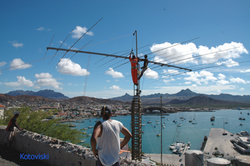Antennas
Most simply, an antenna or aerial is an electronic component designed to transmit or receive radio waves. The words "antenna" and "aerial" are used throughout this article with precisely the same meaning. more...
In the context of engineering and physics, the plural of antenna is "antennas", and it has been this way since about 1950 (or sooner), when a cornerstone textbook in this field, Antennas, was published by John D. Kraus of the Ohio State University. Besides the title, Dr. Kraus noted this in a footnote on the first page of his book. Insects may have "antennae" but not in technical contexts.
More specifically, an antenna is an arrangement of conductors designed to radiate (transmit) an electromagnetic field in response to an applied alternating electromotive force (EMF) and the associated alternating electric current.
Alternatively, if an antenna is placed into an electromagnetic field, that field will induce an alternating current upon the antenna, and EMF between its terminals. See radio frequency induction.
Overview
There are two fundamental types of antennas, which, with reference to a specific three dimensional (usually horizontal or vertical) plane, are either omni-directional (radiate equally in the plane) or directional (radiates more in one direction than in the other). All antennas radiate some energy in all directions but careful construction results in large directivity in certain directions and negligible power radiated in other directions.
By adding additional conducting rods or coils (called elements) and varying their length, spacing, and orientation, an antenna with specific desired properties can be created, such as a Yagi-Uda Antenna (often abbreviated to "Yagi"). Typically, antennas are designed to operate in a relatively narrow frequency range. The design criteria for receiving and transmitting antennas differ slightly, but generally an antenna can receive and transmit equally well. This property is called reciprocity.
Read more at Wikipedia.org




